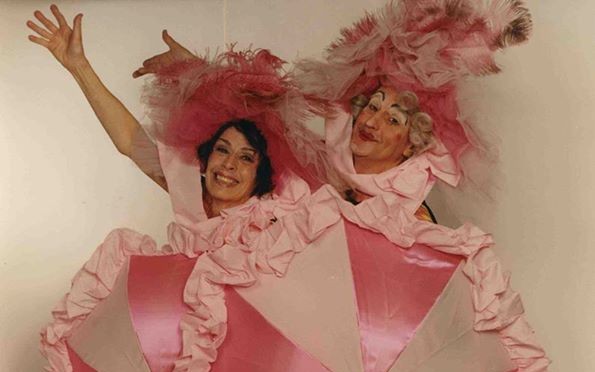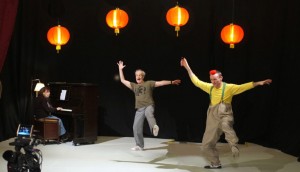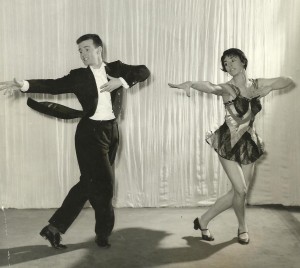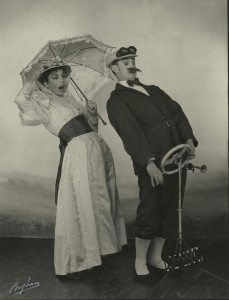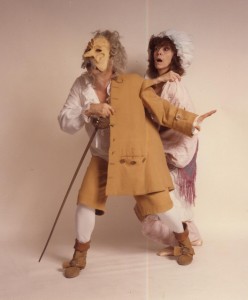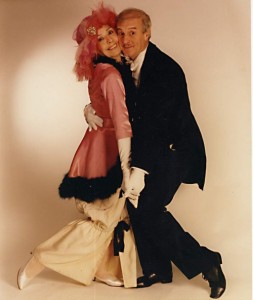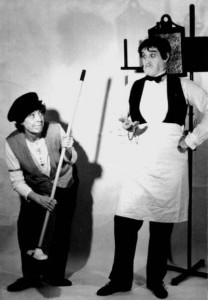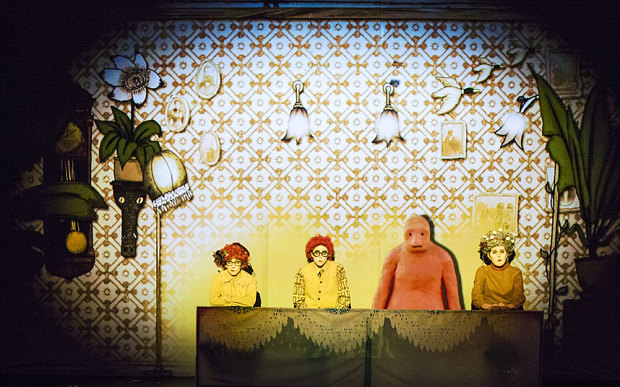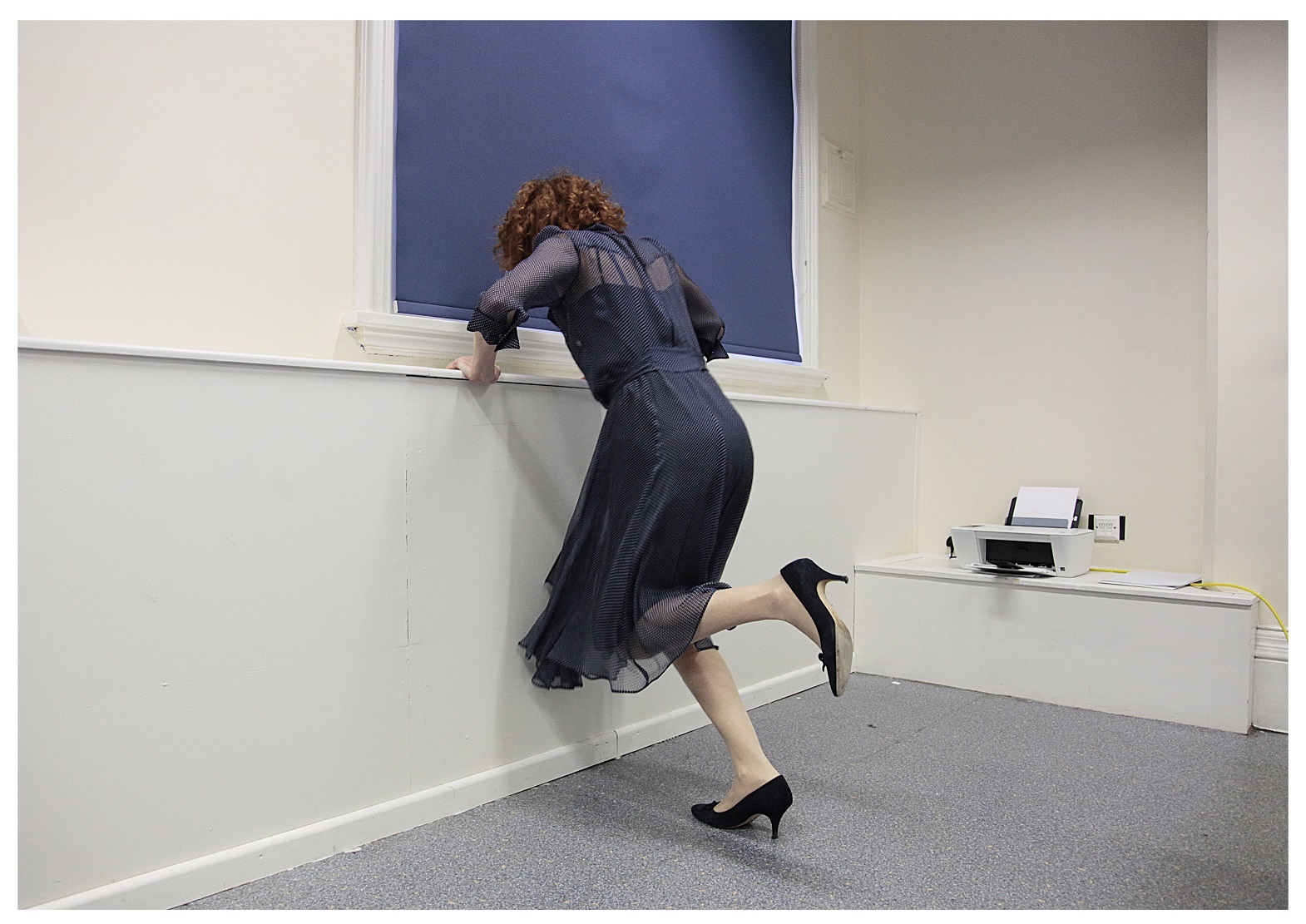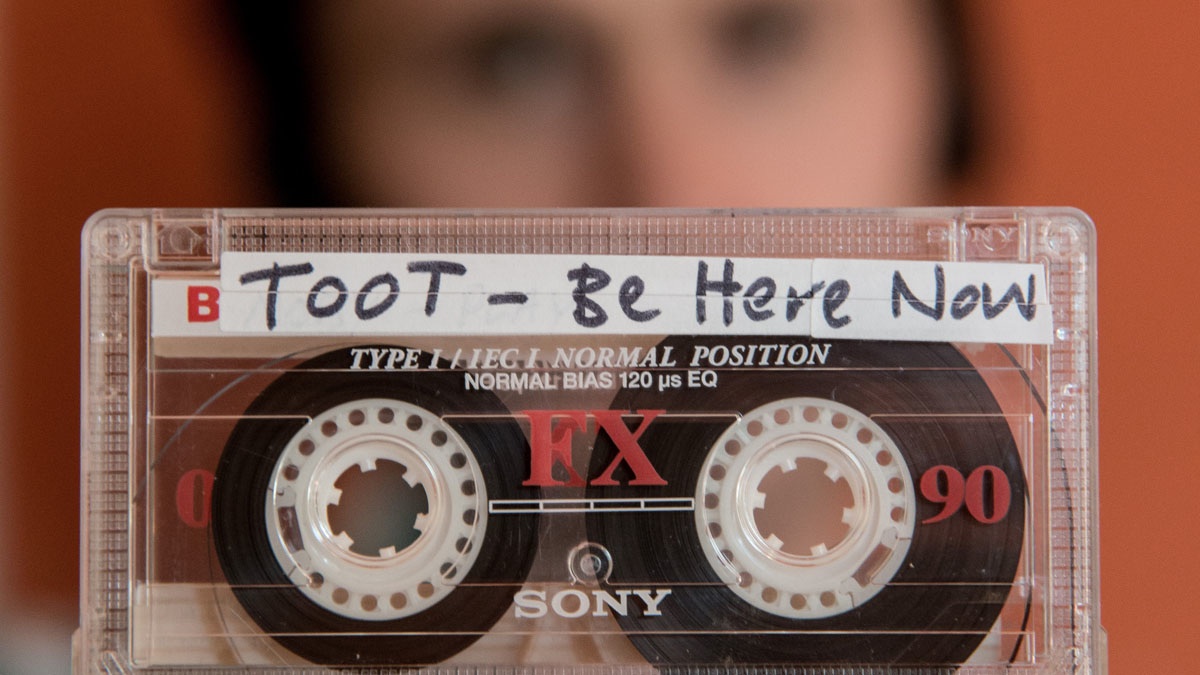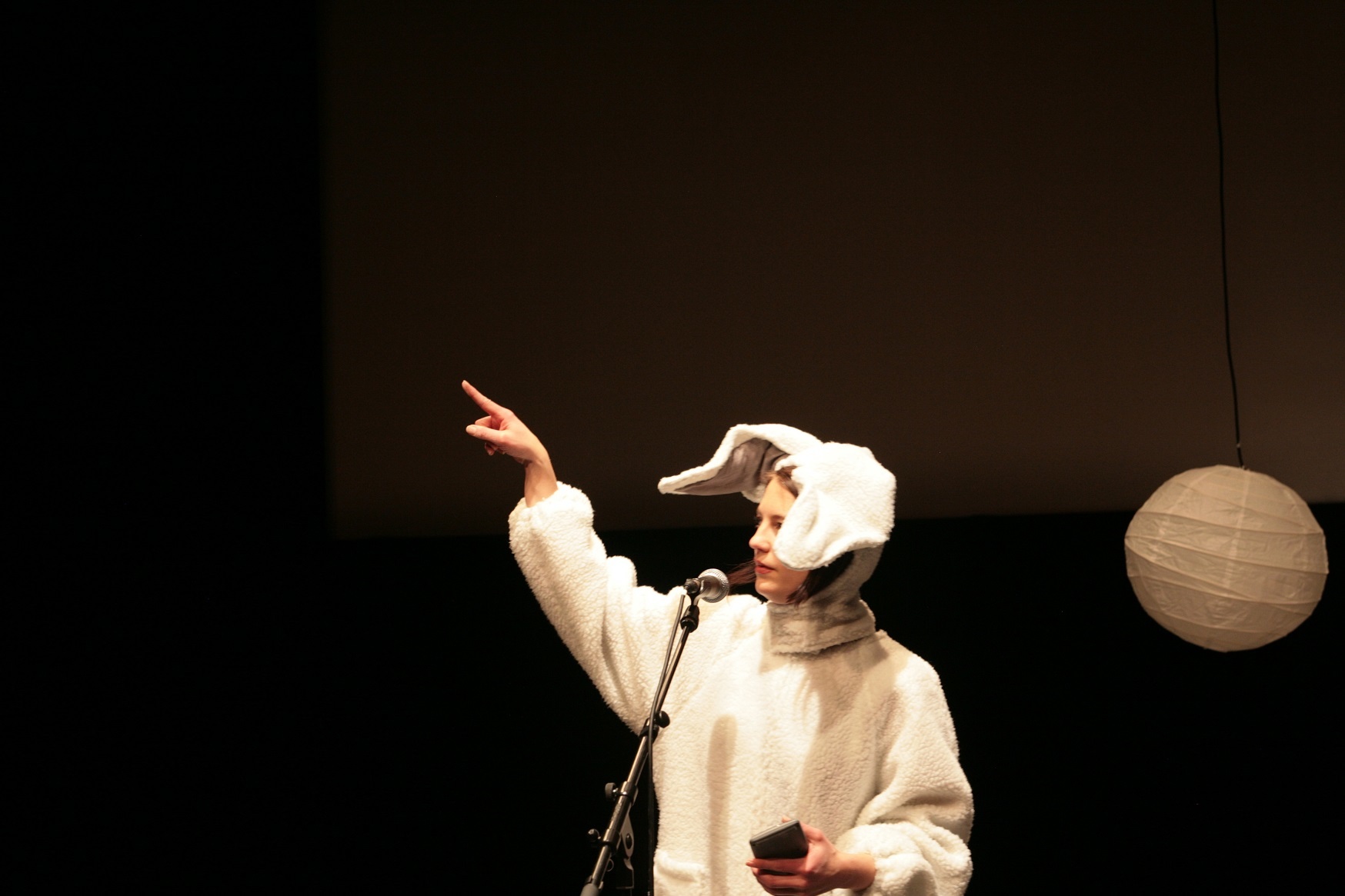Dorothy Max Prior meets Joan and Barry Grantham – purveyors of Eccentric Dance and Popular Theatre…
So here we are at Jacksons Lane, North London. At it again. A motley crew of professional actors and dancers of all sorts, and amateur enthusiasts of varying levels of ability and experience, all whiling away the afternoon doing soft shoe shuffles and high kicks, and channelling the spirit of Laurel and Hardy, Snake-hips Johnson, and Little Titch. We are learning steps with exotic names: the ‘Cup and Saucers’ and the ‘Knives and Forks’; the ‘Scissors’ and the ‘Suzie Q’. Our teacher is Eccentric Dance expert Barry Grantham, whose sprightliness and energy defies the decades that he has been doing this, and we are accompanied on the piano by the wonderful Joan Grantham (aka ‘Joanie, in whom the muses nine combine’ as Barry calls her in the dedication in his book, Playing Commedia).
Later in the afternoon, the ante is upped as we learn the double-act choreography for Me and My Shadow, and attempt to emulate the legendary Wilson, Keppel and Betty’s Egyptian Sand Dance. There’s a bit of singing too as we have a bash at Harry Champion’s Any Old Iron, a classic Music Hall song-and-dance number.
After the class, I’m invited back to Joan and Barry’s delightful little flat in Pimlico. We talk for many an hour, accompanied by the rattle of tea cups and the munching of fairy cakes. The talk is of cabbages and kings and sealing wax and string – and of course about all the things that Joan and Barry have performed, taught, and championed over the decades: Eccentric Dance, Mime, Music Hall, Variety, Commedia dell’ Arte.
We talk, for example, of the difference between Music Hall and Variety. Music Hall came first, says Barry – late 19th to early 20th century – and is characterised by the ‘non-theatre’ set-up of cabaret style small tables and chairs, whilst Variety was performed in regular, proscenium arch theatres. ‘Darling, they had waiters serving beer and hot pies right through the performance!’ says Joan enthusiastically, reflecting on the informal atmosphere of the Music Hall. This was before their time, but they have a direct line to the Music Hall tradition, both through family connections and through their friendships with older colleagues in the entertainment business who made the transition from Music Hall to Variety.
Barry’s maternal grandfather, Fred Bushell, worked the Halls as a singer of comic songs. Although this was all before his time, his Granddad having died when he was a baby, Barry was brought up on stories of Fred running from one venue to another to fit in three or four gigs a night. When he retired, he opened an East End oyster bar: ‘And like everyone else who ran an oyster bar at that time, he always swore that their establishment was patronised by Edward VII and Lillie Langtry,’ says Barry. His parents were actors, meeting during a performance of The Merry Wives of Windsor. His father performed as Pierrot in a Commedia-inspired production (a revival of a play by Laurence Housman called Prunella; or Love in a Dutch Garden), and Barry himself was initiated into the theatre arts at a tender age, creating a mime scenario under the coaching of his father: ‘Really, a Marcel Marceau type thing – about Pierrot waiting for a letter… All very French, rather than Italian.’ By the age of 12, he was not only performing but also teaching at his mother’s ballet school.
At the age of 15 – ‘I had to pretend I was 16 to get the job’, he says – Barry was a very promising young dancer, who had just joined the cast of The Song of Norway, on at the Palace Theatre, Cambridge Circus, at the heart of London’s West End. ‘I came running on in my little Norwegian trousers – rum tum tum ta! – and I saw this rather beautiful girl – very beautiful girl – dancing with a pillow.’ The girl was Joan. And what was her reaction to the new boy? ‘Well,’ says Joan, ‘I do remember he had very nice legs.’
Although they didn’t become an ‘item’ immediately, it was the start of a lifelong relationship of shared work, friendship and love. Joan is a dancer, musician, and comedienne, coming from what she describes as an ordinary family (albeit a ‘very musical family’), getting her love for the performing arts from ballet and music lessons, taking her exams and grades, and picking up work where she could. In those days, she was making her living both from playing the piano (especially music from classic Hollywood films, on which her knowledge has become encyclopaedic) and dancing – after the Song of Norway, she continued with a string of West End shows, including Scheherazade with the Lifar Company at the Cambridge Theatre. Barry, post Song of Norway, reaped the rewards of being that rare thing, a good male ballet dancer, much in demand on stage and film. (He appeared in Red Shoes with Moira Shearer, amongst other glory moments.)
At first their paths crossed only intermittently, but after a year or two there came a point when they decided to throw in their lot together. ‘The marriage license being rather cheaper than paying a pianist,’ Barry says mischievously. So a union was formed – not just a marriage, but also a dance partnership. Barry invited Joan to join him in training with Idzikowski, who worked with Diaghilev. Joan introduced Barry to popular and stage-dance forms: ‘I’m a ballet boy,’ says Barry. ‘Joan taught me everything I know about musical theatre.’ Together, Joan and Barry created an act that they took to the Variety theatres – both of them dancing, Barry choreographing, and Joan composing the music. Their influences were many and various, from the Russian ballet to musical theatre via Hollywood film – especially films starring Gene Kelly and Fred Astaire (Joan’s personal favourite). They also acknowledge the debt they owe to their friends and colleagues, such as Paddy Stone, Beryl Kaye and Irving Davies (known collectively as Three’s Company – for whom Joan wrote the music). Davies in particular was a renowned dancer and choreographer who had worked with Gene Kelly, and who choreographed many West End shows, working right up to his death (in 2012) on his last production, Sean Foley and Hamish McColl’s tribute to Morecambe and Wise, The Play Wot I Wrote.
Like Irving Davies, Joan and Barry were mostly interested in taking dance into a new direction that embraced ballet, modern, and what used to be called ‘stage dance’. They forged routines that aimed to stretch the boundaries of dance whilst still being entertaining: ‘We were breaking all the rules of Variety – we didn’t conform to the patterns that most people expected,’ says Barry. Joan’s musical compositions, he tells me proudly, were complex and unusual, often causing consternation to the musicians when presented at band call. He recalls the occasion when one bandleader, Sid Caplin at Hackney Empire, said: ‘What’s this? My bass player – 48 bars rest time? I’m not paying him to have 48 bars rest time!’
What they weren’t too interested in, perhaps surprisingly, was the form that we now call Eccentric Dance. ‘ Not at all! It’s funny that I have ended up teaching all this stuff we were trying to get away from!’ says Barry, although he is quick to reassure me that he always had great admiration for the Variety legends he worked alongside, it was just that he and Joan had different ambitions. ‘We were of a new generation’ says Barry, and Joan adds ‘Things were changing, all those old acts weren’t going anywhere, and we wanted to go somewhere different, to stick with it and do things you wouldn’t expect.’
Although Joan and Barry entered Variety at a time that it was in decline, they worked with many of the genre’s legendary figures, including Max Miller (‘The Cheeky Chappie’), who they admire greatly, saying ‘he was wonderful to watch’, being particularly impressed by his ability to single out and relate one-on-one to members of the audience, even in a large theatre. This Barry sees as akin to his other great theatrical love, Commedia – the skill in engaging the audience and bringing them into the performance action that has come down the ages from Commedia dell’Arte to Music Hall, Pantomime, Variety and contemporary Street Theatre performance. ‘He liked to have the house lights up – he liked to see the audience – he had incredible skill in talking to the audience.’
Variety bills the couple played on also featured so-called Speciality Acts such as the wonderful Adagio dance troupe The Ganjou Brothers and Juanita; and aforementioned Wilson, Keppel and Betty, whose famous Cleopatra’s Nightmare was devised as a response to the interest in the finding of Tutankhamen’s tomb in the 1920s – and was still being danced in the 1950s. At least, Jack Wilson and Joe Keppel were still dancing it. Betty Knox had long retired from the dance, and indeed had a very successful second career as a journalist, famously reporting from the Nuremberg Trial for the Evening Standard. Her daughter Patsy became Betty Number Two, and when she left there were a whole succession of new Betties. No one is quite sure how many, but Richard Anthony Baker, author of ‘Old Time Variety – an illustrated history’ claims eight or nine. Barry isn’t sure what number Betty they were on at the time he performed alongside them – what he does know is that she couldn’t hold a light to the original Betty: ‘There’s a part where the boys go and get changed, and Betty does a Dance of the Seven Veils,’ he says. ‘I wasn’t very impressed. Not at all sexy…’
How, then, did it happen that Joan and Barry ended up being known as Eccentric Dancers? A life treading the boards takes many twists and turns. As well as their ‘serious’ dance pieces, Joan and Barry created comic vignettes that were tributes to film stars such as Charlie Chaplin, and the Marx Brothers (‘Joan was Harpo and I was Groucho’). They toured on the Variety circuit for a few years – doing theatres all around the country, summer seasons, and pantomime – but this was the 1950s and Variety was in decline: theatres were becoming cinemas, TV was snapping up the singers and the comics. Joan and Barry moved into cabaret and cruise-ship work. Barry also became much in demand as a choreographer, working in theatres and with showgirl troupes (often alongside choreographer/producer and renowned Can Can teacher Marie de Vere, whose comment on his work was: ‘You’re very good, but you’ll have to shift yourself’ – the expectation was for him to get four routines made a day!)
Somewhere along the way, word got out that Barry had a background in Variety, and that he knew (and had learnt from) many of the legendary comic and character dancers of the day, and so it was only a matter of time before the demand to teach the classic routines came his way. This was many decades before the advent of DVDs and YouTube, both now an invaluable source for studying vintage dance routines. Then, if you wanted to learn, say, ‘At The Ball’ by Laurel and Hardy, there was nowhere to crib from; you needed to find someone who knew it. Step up, Barry Grantham!
But there is more to life than Eccentric Dancing, and Barry is also a renowned expert in both classic Commedia dell’Arte and its contemporary successor, Commedia. That childhood role of Pierrot was reprised many times, with Barry also embracing Harlequin – and eventually all the Masks (as Commedia characters are called, regardless of whether they are actual masked characters or not). Traditionally a performer might spend his whole career portraying a single Mask but Barry is more interested in seeing how each character feels under the mask and at some point has worked on, and in, most of the famous one. Indeed, he and Joan have a show called Harlequin Unmasked in which they explore the whole gamut. His interest in Commedia burgeoned after the demise of the Variety days. He saw the renowned Piccolo Theatre from Milan (‘inspiring, incredible,’ says Barry), performing Servant of Two Masters – Carlo Goldoni’s fully scripted play, written in protest at the poor standard of improvisation to which the Commedia dell’Arte of the day had sunk – a perennial comic theatre favourite that recently re-surfaced as the National Theatre production One Man, Two Guvnors (currently touring the UK). His early interest in the form thus piqued, he took himself to Italy to study with the masters of the form, and read anything he could find about Commedia dell’Arte, forging an intensive education for himself.
So we are now in the late 1960s and 1970s, and Barry (with his renewed interest in and growing knowledge of) Commedia dell’Arte is invited to teach workshops in Mime, Improvisation, and Commedia at the Oval House Theatre and the City Lit – both hot-spots of alternative theatrical activity in the emerging scene of agit-prop and devised theatre. Alongside the experiments in theatre form coming from the likes of The People Show, Lumiere and Son, and Crystal Theatre of the Saint, there was a parallel interest developing in classic forms, including: Mime, Acrobatics, Clown and Commedia dell’Arte. More than mere revival, re-interpretation and integration into new ways of working were the order of the day. By the late 1970s, an enterprising young theatre producer called Joseph Seelig had started the London International Mime Festival. Physical, visual, ‘total theatre’ was breaking through – not as a replacement of the literary tradition led by authors, but honouring actor-led theatre forms as a parallel force.
By the early 1980s a whole new generation of physical theatre-makers had arrived on the scene. Over the 1980s and 1990s, and beyond into the 21st century, emerging artists working in the burgeoning artforms of physical and devised theatre, street theatre and contemporary circus were looking to experts in the non-literary performance traditions for general guidance and (even more vital) hard-core skills. Barry Grantham thus found himself much in demand teaching mime, movement and Commedia techniques to companies such as Zippos Circus, No Fit State, Told by an Idiot, and Gifford’s Circus. In more recent years, as physical theatre and circus entered the mainstream, he found himself working in opera (at Glyndebourne and at the Royal Opera House), for the Royal Shakespeare Company, and for numerous other notable establishments across the UK and Europe.
Barry defines contemporary Commedia, as distinct from the classic Commedia dell’Arte, as a form ‘not restricted to either stereotypes of doubtful relevance or male-dominated orientations’ (this quote taken from the introduction to his excellent book Playing Commedia). He sees it as a theatre of allusion, not illusion, and notes five characteristics of Commedia. It is a non-naturalistic form in which the physical/visual elements are at least equal to the verbal. It makes use of the multiple skills of the performer, incorporating spoken text, dance, mime, acrobatics, and music. It may be improvised but incorporates learnt set pieces. It may feature ‘permanent’ characters, traditional or new. And it may use face masks – in traditional Commedia dell’Arte, this would be the distinctive half-masks, often beautifully crafted in leather. In Playing Commedia, Barry discusses the mask as used in more recent performance. He talks of the creation of an ‘identifiable image’ and cites Charlie Chaplin’s Little Tramp character –replete with bowler hat and the little moustache – as a Mask: ‘A clearly recognised individual who raises certain expectations in the audience.’
Concurrent to the teaching work, the Commedia troupe Intention (founded and led by Barry) has performed extensively, and Joan and Barry continue to present their legendary classes, workshops, performances and lecture-demonstrations on Eccentric Dance, Music Hall and Commedia. They have two touring shows: Working the Halls, which tells true-life stories from the world of Music Hall and Variety, and the aforementioned Harlequin Unmasked.
This may well be a good moment to reflect on the fact that Barry sees little distinction between his work with Eccentric Dance and Variety, and his work with Commedia. ‘It’s all one,’ he says, meaning that it is all part of the same great whole thing that is popular theatre. In this, there is an analogy (which we discuss keenly) with the Balinese approach to art-making, in which everyone is expected to dance, sing, puppeteer, and perform the Topeng masks. As Antonin Artaud, Eugenio Barba, and Peter Brook have all pointed out, the divide between ‘actor’ and ‘dancer’ is less likely in Eastern traditions. The same can be said for the Commedia dell’Arte – traditionally a ‘commedian’ would be expected to competently dance, deliver text, sing, and play at least one musical instrument.
The conversation turns to more recent examples of multi-tasking performers, this prompting a discussion on the crossover between Variety and what some people call ‘legitimate theatre’. I tell Joan and Barry that I was lucky enough to have seen Max Wall in John Osborne’s The Entertainer at Greenwich Theatre: ‘So often Variety performers like Max Wall and Beryl Reid seem to have a greater depth than the so-called real actors,’ says Barry.
For those of us lucky enough to have experienced the Granthams’ teaching first-hand, we know that we are learning in a way that has been part of theatre history for many hundreds of years. Physical warm-ups that emphasise the isolation of body parts; tricks and turns and set pieces passed down from one generation of performers to another; comic dances that play on each performer’s unique appearance and abilities; an awareness of staging and relationship to audience. Long, long before the advent of university degrees in theatre, dance and circus, this was what you learnt and how you learnt it – from the horse’s mouth (or hooves, perhaps) – and what we learn from Joan and Barry is invaluable.
When I ask Barry what his fondest moment is from all these experiences over all these years, he says ‘Doing the class this afternoon!’ Which is slightly tongue-in-cheek, but there is a seriousness here. He’s more interested in what’s happening now, in the present moment, than in anything that has happened in the past. And he’s not done yet: there are unfulfilled ambitions: ‘It’s not really about what was – I’ve got something to do. I have a vision of Commedia and I have never achieved it. I don’t mean that it’s a total re-creation, but it’s what could be: masked work with brilliant actors, dancers, musicians. That’s what I’ve got to do – and I haven’t got much time to do it. You never know…’
So there’s an artist for you – ‘I’m happy, but still striving,’ he says.
Constantly on the move, looking to the next challenge.
We wait with baited breath to see what the next instalment of the very full and eventful theatrical lives of Joan and Barry Grantham bring forth.
More about Joan and Barry Grantham:
For further information on Joan and Barry Grantham see the World of Commedia website http://www.worldofcommedia.co.uk/
The Eccentric Dance class continues at Jacksons Lane on Tuesdays 2pm to 4pm, starting 13 January 2015 http://www.jacksonslane.org.uk/
Two weekend intensives in early 2015 at Sands Film Studios, Rotherhithe, London: http://www.sandsfilms.co.uk/Sands_Films_Studio/Contact_%26_Address.html
Music Hall Techniques: 23–25 January 2015
Commedia – A Technique for Comedy: 30 January –2 February 2015
Each weekend comprising an evening slide-talk on the Friday, followed by a two-day workshop.
23 January slide-talk: Working the Halls
30 January slide-talk: Commedia – Its History and Application
Bookings and further information: email gbarry.grantham@ntlworld.com or tel 0207 798 8246
Barry Grantham will be teaching Commedia dell’Arte at the Chalemie Easter School, Oxford, 28 March – 2 April 2015 http://www.chalemie.co.uk/
Books by Barry Grantham:
Playing Commedia – A Training Guide to Commedia Techniques (NHB, 2000)
Commedia Plays – Scenarios, Scripts, Lazzi (NHB, 2006)
Both available to purchase from www.nickhernbooks.co.uk
Dorothy Max Prior is a choreographer, director and dance teacher, and co-director of The Ragroof Players www.ragroofplayers.co.uk and also runs projects using popular dance and theatre under the name Dorothy’s Shoes. Her five-day residential course Eccentric, Popular and Comic Dance for Actors and Clowns is now booking for June 2015 at The Actors Space in Barcelona. Email aureliusproductions@gmail.com for further information.

